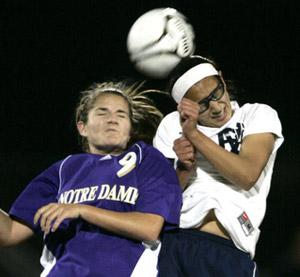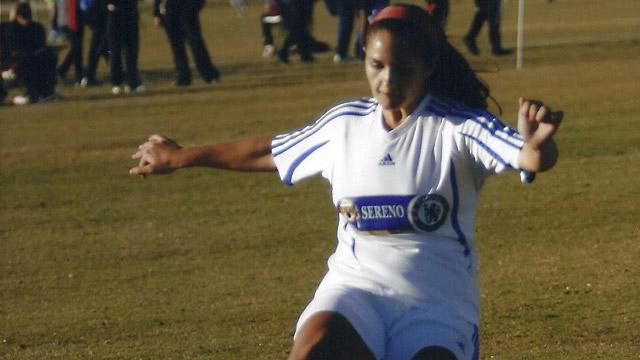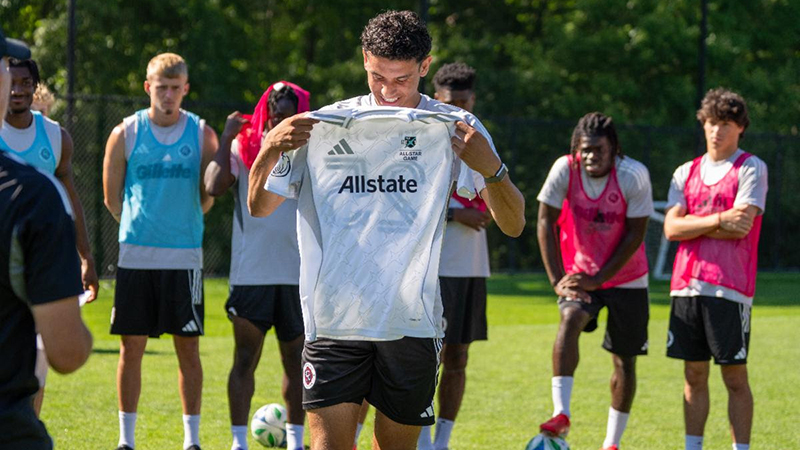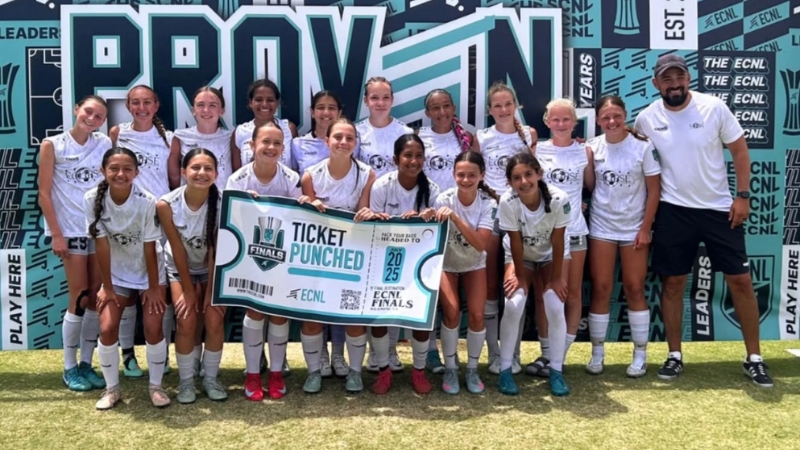 Cadie Naquin (left) competes.
Cadie Naquin (left) competes.Club & High School Soccer Together for Never

As Andy Williams – singer, songwriter, and musician extraordinaire – sings of the holiday season, “It’s the most wonderful time of the year with the kids jingle belling and everyone telling you, ‘Be of good cheer.’” But for me and numerous other soccer players across the country, the hap-happiest season of all does not bring jingle belling or good cheer. Instead, the winter season brings disappointment.
As opposed to most people who spend the holidays eating, sleeping, drinking, and being merry, competitive, college-bound soccer players use this holiday “time off” during the last couple months of the year to show their stuff at several vital college showcases across the nation. For prospective collegiate student-athletes, these winter showcases are invaluable and are often the deciding factor for college soccer coaches who are putting forth their best efforts to observe and recruit the players who will best bring success to their college soccer programs.
 Cadie Naquin (left) competes.
Cadie Naquin (left) competes.I absolutely love high school soccer for more reasons than one. My whole life, I have been driven to succeed by fear of my own personal failure. Coaches tell me, “If you want that scholarship, you’d better work harder,” or “If you want to survive at the next level, you’d better leave everything you’ve got in you on the field, every single day.” These motivations work wonders, especially on players like me who burn with a passion to play at the next level.
But the motivations are solely self-serving and always yield only personal gain. High school soccer, on the other hand, is all about community. Any motivation is team-oriented; for example, winning a state championship. There is nothing to be won for the individual. When I play on my high school team, I am competing for something much, much bigger than just myself; I am playing for my team, my school, my friends, my teachers, my community.
Each day I step foot into our high school gymnasium I see a banner reading, “2009 Girls Soccer 4A-II State Champions” and my heart swells with pride.
The banner does not include my name or the name of any other player, but I am more proud of my contribution to that victory than I am of the majority of my personal accomplishments.
In addition to this, my high school, as do the other thousands of high schools in America, provides me with the tools to succeed outside of the soccer world. Playing high school soccer is my opportunity to give back to my school in return for the tools they have given me. If not for my high school, I would never be able to succeed on the college soccer field because I would not have the ability to succeed in the college classroom.
High school soccer also is a reminder to celebrate our successes. Too often in club soccer, we focus on the next game, the next tournament, or the next season. We frequently forget to stop and celebrate the moment. That is not the case in high school soccer. It is a season that truly comes to an end and cannot be recreated. The next year, beloved seniors will have graduated, there will be new freshmen, and maybe there will even be a new coach. So, each high school victory is heartfelt and savored.
Besides, what better mirrors the college soccer team dynamics than high school soccer? Freshmen and sophomores get the underclassmen brunt and are forced to prove themselves, while juniors and seniors get the chance, for some the first time in their lives, to lead.
Yes, it is true that high school soccer is not on the same level as club soccer. It is a mixture of soccer players from different soccer backgrounds; some have competitive experience from club or ODP, while others do not and simply enjoy playing the game at a recreational level – in other words, for fun.
And for boys and girls who aspire to play soccer at the next level at a Division 1 Top 25 Ranked school, playing high school soccer may not be the right choice for them. But nonetheless, both high school and club soccer should always be an option, simultaneously or not, and schools and clubs should work together so one does not happen at the expense of the other.
But some of us, especially those of us who represent the state of Arizona, do not have the option of playing high school soccer without giving up club soccer altogether. This issue does not affect numerous other states across the country whose high school soccer seasons are in the fall or spring. But in Arizona, with a winter soccer season, if players remain loyal to their high schools and choose to play, they do so at their own expense, sacrificing the numerous college showcases that are played during the winter season, and possibly opportunities and our own futures in the college soccer arena.
The AIA (Arizona Interscholastic Association), which oversees high school sports and proposes multiple rules in the state of Arizona, continues to forbid students to participate in both club sports and high school athletics simultaneously as the organization has in the past, locking the two sides in a battle for players and forcing the athletes to choose between the two. This rule boldly states that while participating in certain high school sports, no athlete should additionally engage in other associations, including club sports and travel teams. So what is the purpose of a rule so limiting as this? I have yet to come up with an answer myself or to hear a sensible response from those in authority.
When in discussions about the issue of forcing athletes to choose between club and high school teams, I hear several justifications, but they simply do not make sense. Interestingly, I could play high school basketball or volleyball and club soccer at the same time, so the issue is not related to overtraining or the preservation of young athletes’ bodies. And are these organizations out to get the elite soccer players off the high school teams to even the playing field? This surely does not make sense, because athletes compete without any problems in every other high school sport, regardless of their competitive or recreational abilities. Is it an effort to prevent athletes from overcommitting to activities during their busy schedules? But this cannot be the reason either, for competitive athletes are permitted to participate in Olympic Development Program events throughout the entire high school season. Also, the Disney College Showcase and ECNL events in Orlando, Florida, take place during the two-week moratorium in the high school soccer season over the winter break, during which no high school soccer games take place. High school soccer players with winter soccer seasons are required to skip these December tournaments because of the rules prohibiting the playing of club soccer and high school soccer simultaneously, even though these players have no high school obligations with which their club tournament travel would interfere.
So am I then to conclude that it is an overall misunderstanding? The authorities must simply be unaware of the harm inflicted on the collegiate futures of soccer athletes who do choose to remain loyal to their schools. It is important to remind people that when I graduate from this stage in my life I will be moving forward to the college world, where I will be competing at the next level in every aspect of my life: academics, athletics, and self-responsibility (laundry and cleaning here I come), representing my soccer club, high school, and state of Arizona every step of the way. My playing college soccer benefits each of these entities. Representing my high school on the playing field should not hinder my ability to represent my community in the future.
So what do I want this lonely Christmas, left to check my team’s tournament scores on the internet from my living room couch? I hope that this year, every rule creator, decision maker, and regulator got a stocking filled with wisdom to see this issue in a new light. As for me, it is December of my junior year. My high school journey is coming to an end and I have no regrets, for my decision to play high school soccer each year has defined me as the player and the person I have chosen to be. Let all my Christmas wishes go to those who come after me whose journeys are just beginning, that their loyalty to their high school is not calculated in terms of collegiate opportunities lost. Hopefully those of us whose collegiate futures have been put at risk by choosing to remain loyal to our schools will one day be watching the NCAA Women’s Soccer National Championship on the big screen between two teams, each comprised of girls who played high school soccer without fear.
Headlines
- Recruiting Roundup: June 23-July 6
- 2025 Women's Division I Transfer Tracker
- How Do I Get Scouted by TopDrawerSoccer?
-
ECNL Girls Playoffs: The U14 Stars

-
Girls Academy U15 Finals Preview

- TDS Girls Regional Rankings: Class of 2027
-
ECNL Boys Playoffs: Best from the U15s

- MLS NEXT All-Star Game Rosters Announced
-
Player Rankings Spotlight: 2027 Boys

-
ECNL Boys Playoffs: Crossfire on Top




